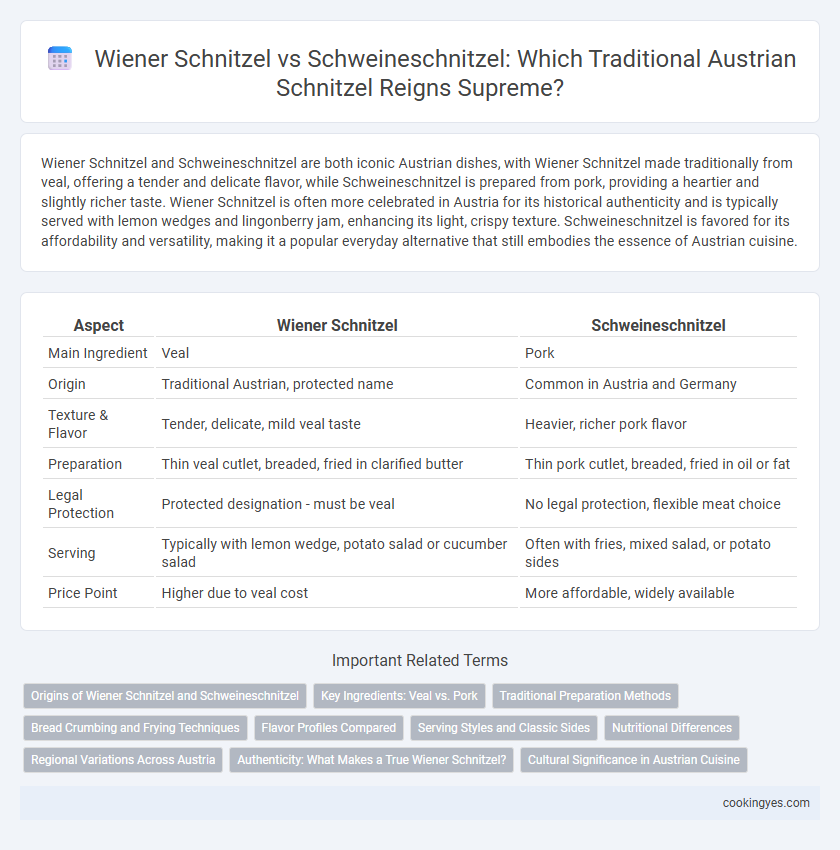Wiener Schnitzel and Schweineschnitzel are both iconic Austrian dishes, with Wiener Schnitzel made traditionally from veal, offering a tender and delicate flavor, while Schweineschnitzel is prepared from pork, providing a heartier and slightly richer taste. Wiener Schnitzel is often more celebrated in Austria for its historical authenticity and is typically served with lemon wedges and lingonberry jam, enhancing its light, crispy texture. Schweineschnitzel is favored for its affordability and versatility, making it a popular everyday alternative that still embodies the essence of Austrian cuisine.
Table of Comparison
| Aspect | Wiener Schnitzel | Schweineschnitzel |
|---|---|---|
| Main Ingredient | Veal | Pork |
| Origin | Traditional Austrian, protected name | Common in Austria and Germany |
| Texture & Flavor | Tender, delicate, mild veal taste | Heavier, richer pork flavor |
| Preparation | Thin veal cutlet, breaded, fried in clarified butter | Thin pork cutlet, breaded, fried in oil or fat |
| Legal Protection | Protected designation - must be veal | No legal protection, flexible meat choice |
| Serving | Typically with lemon wedge, potato salad or cucumber salad | Often with fries, mixed salad, or potato sides |
| Price Point | Higher due to veal cost | More affordable, widely available |
Origins of Wiener Schnitzel and Schweineschnitzel
Wiener Schnitzel is an iconic Austrian dish originating from Vienna, traditionally made with veal, showcasing a thinly pounded cut, seasoned, breaded, and fried to golden perfection. Schweineschnitzel, a pork-based variant, became popular in Austrian cuisine as a more affordable alternative to the veal Wiener Schnitzel, with roots tracing back to regional adaptations in Austria and neighboring countries. The distinction between the two lies primarily in the meat used, with Wiener Schnitzel protected by Austrian law to ensure authenticity and maintain its cultural heritage.
Key Ingredients: Veal vs. Pork
Wiener Schnitzel is traditionally made with veal, offering a tender and delicate flavor integral to authentic Austrian cuisine. Schweineschnitzel, on the other hand, uses pork, resulting in a slightly richer and more robust taste while still honoring the classic breaded and fried preparation. The choice of meat profoundly influences texture, flavor profiles, and the overall traditional authenticity of this iconic dish.
Traditional Preparation Methods
Wiener Schnitzel is traditionally made from veal, pounded thin, breaded with flour, egg, and breadcrumbs, then fried in clarified butter to achieve a golden, crispy crust while maintaining a tender interior. Schweineschnitzel, using pork, follows a similar breading and frying technique but often includes variations such as seasoning in the breadcrumb mixture or serving with different sauces. The preparation methods emphasize careful pounding, consistent breading, and frying at the right temperature to preserve the classic texture and flavor profiles distinctive to Austrian culinary heritage.
Bread Crumbing and Frying Techniques
Wiener Schnitzel requires finely ground breadcrumbs made from day-old white bread, which are gently pressed onto thin veal fillets to ensure a light, crispy crust. Schweineschnitzel, typically prepared with pork, uses coarser breadcrumbs that create a heartier texture, best suited for thicker cuts. Both are fried in clarified butter or a neutral oil at medium-high heat, achieving a golden, evenly cooked exterior while preserving juicy, tender meat inside.
Flavor Profiles Compared
Wiener Schnitzel, made exclusively from veal, offers a delicate, tender texture with a mild, slightly nutty flavor that complements the crispy breadcrumb coating. Schweineschnitzel, prepared from pork, delivers a richer, more robust taste with a slightly fattier and juicier bite, intensifying the overall savoriness of the dish. Both variations feature the classic golden crust, but their distinct meat characteristics create unique traditional Austrian flavor experiences.
Serving Styles and Classic Sides
Wiener Schnitzel, made exclusively from veal, is traditionally served with a lemon wedge, lingonberry jam, and either potato salad or parsley potatoes, emphasizing its classic Viennese presentation. Schweineschnitzel, crafted from pork, often comes breaded and fried similarly but is frequently accompanied by varied serving styles such as Jagerschnitzel with mushroom sauce or Zigeunerschnitzel with bell pepper sauce, paired with fries or spaetzle. Both dishes highlight Austria's rich culinary heritage, but Wiener Schnitzel's protected status dictates stricter traditional accompaniments compared to the more versatile Schweineschnitzel.
Nutritional Differences
Wiener Schnitzel, traditionally made from veal, contains higher protein levels and more essential amino acids compared to Schweineschnitzel, which uses pork. Schweineschnitzel typically has a higher fat content, including more saturated fats, affecting overall calorie intake. Both dishes provide substantial amounts of B vitamins, but Wiener Schnitzel is often considered leaner and lower in cholesterol, making it a slightly healthier option in traditional Austrian cuisine.
Regional Variations Across Austria
Wiener Schnitzel, made exclusively from veal, remains the iconic traditional dish especially in Vienna and eastern Austria, symbolizing authentic Austrian culinary heritage. Schweineschnitzel, prepared with pork, is more prevalent in western regions like Tyrol and Vorarlberg, reflecting local preferences and economic influences. Regional variations emphasize differing meat choices and preparation methods, highlighting Austria's diverse gastronomic landscape within the Schnitzel tradition.
Authenticity: What Makes a True Wiener Schnitzel?
A true Wiener Schnitzel is made exclusively from veal, thinly pounded and coated in a simple mixture of flour, egg, and breadcrumbs, ensuring its protected status under Austrian culinary tradition. Schweineschnitzel, made from pork, is a popular variation but lacks the official designation of authenticity that only veal confers. Authentic Wiener Schnitzel must be fried in clarified butter or oil to maintain its delicate texture and distinct flavor that epitomizes traditional Viennese cuisine.
Cultural Significance in Austrian Cuisine
Wiener Schnitzel, made exclusively from veal, holds a protected designation and symbolizes Austrian culinary heritage with its delicate, tender texture and golden, crispy crust. Schweineschnitzel, crafted from pork, is a popular variation offering a richer flavor and greater accessibility, reflecting everyday Austrian dining culture. Both dishes embody Austria's gastronomic identity, though Wiener Schnitzel remains the cultural icon celebrated in traditional festivities and prestigious menus.
Wiener Schnitzel vs Schweineschnitzel for traditional Austrian dish Infographic

 cookingyes.com
cookingyes.com